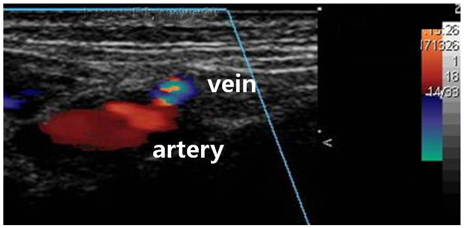Korean Circ J.
2010 Dec;40(12):677-679. 10.4070/kcj.2010.40.12.677.
A Rare Case of Radial Arteriovenous Fistula After Coronary Angiography
- Affiliations
-
- 1Division of Cardiology, National Health Insurance Corporation Ilsan Hospital, Goyang, Korea. jooyy11@paran.com
- KMID: 2225168
- DOI: http://doi.org/10.4070/kcj.2010.40.12.677
Abstract
- The percutaneous transfemoral approach has been routinely used for cardiac catheterization and coronary angioplasty. Local vascular complications following angioplasty are seen in 5% to 10% of patients, especially in those who need prolonged anticoagulation. Transradial access for coronary procedures dramatically reduces access site complications. We report a rare case of radial arteriovenous fistula, which developed after coronary angiography perfomed using the transradial approach.
MeSH Terms
Figure
Reference
-
1. Judkins MP. Selective coronary arteriography: part I. a percutaneous transfemoral technic. Radiology. 1967. 89:815–824.2. Popma JJ, Satler LF, Pichard AD, et al. Vascular complications after balloon and new device angioplasty. Circulation. 1993. 88:1569–1578.3. Rozenman Y, Gilon D, Zelingher J, et al. One stage coronary angiography and angioplasty. Am J Cardiol. 1995. 75:30–33.4. Agostoni P, Biondi-Zoccai GG, de Benedictis ML, et al. Radial versus femoral approach for percutaneous coronary diagnostic and interventional procedures: systematic overview and meta-analysis of randomized trials. J Am Coll Cardiol. 2004. 44:349–356.5. Eichhöfer J, Horlick E, Ivanov J, et al. Decreased complication rates using the transradial compared to the transfemoral approach in percutaneous coronary intervention in the era of routine stenting and glycoprotein platelet IIb/IIIa inhibitor use: a large single-center experience. Am Heart J. 2008. 156:864–870.6. Pulikal GA, Cox ID, Talwar S. Radial arteriovenous fistula after cardiac catheterization. Circulation. 2005. 111:e99.7. Spence MS, Byrne J, Haegeli L, Mildenberger R, Kinlock D. Rare access site complications following transradial coronary intervention. Can J Cardiol. 2009. 25:e206.8. Kent KC, McArdle CR, Kennedy B, Baim DS, Anninos E, Skillman JJ. A prospective study of the clinical outcome of femoral pseudoaneurysms and arteriovenous fistulas induced by arterial puncture. J Vasc Surg. 1993. 17:125–133.9. Perings SM, Kelm M, Jax T, Strauer BE. A prospective study on incidence and risk factors of arteriovenous fistulae following transfemoral cardiac catheterization. Int J Cardiol. 2003. 88:223–228.10. Campeau L. Percutaneous radial artery approach for coronary angiography. Cathet Cardiovasc Diagn. 1989. 16:3–7.11. Kiemeneij F, Laarman GJ. Percutaneous transradial artery approach for coronary stent implantation. Cathet Cardiovasc Diagn. 1993. 30:173–178.
- Full Text Links
- Actions
-
Cited
- CITED
-
- Close
- Share
- Similar articles
-
- Radial Arteriovenous Fistula after Coronary Angiography
- Radial Arteriovenous Fistula Developed Late after Coronary Angiography: A Case Report
- Bilateral Congenital Coronary Arteriovenous Fistulas
- A Case of Percutaneous Transcatheter Coil Embolization for Congenital Coronary Arteriovenous Fistula
- An Iatrogenic Coronary Arteriovenous Fistula Caused by Guidewire Trauma during Percutaneous Coronary Intervention



